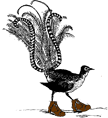Hut Etiquette - Bush Walking Victoria
A guide to the use and care of our mountain huts
We hope that everyone who visits mountain huts or refuge shelters in the Victorian country areas will appreciate the experience - the huts form a valuable part of our historical heritage. Most huts were built for use by cattlemen, government authorities or ski clubs, or for emergency use as refuges for people in difficulty with adverse weather, illness or injury. You should not rely on huts for regular accommodation. You may not be able to locate huts in bad weather, should an emergency arise. When you walk in mountain areas it is essential that your party be self-contained; carrying tents, stoves, sleeping bags, food, maps and compass.
.......A final note
Leave a copy of your plans with a responsible person; a friend or relative, a ranger or the police. Or leave a clearly visible note in your vehicle, for example above the sun visor.
Use of huts
The use of huts is a privilege, not a right. All bushwalkers should be equipped to camp out at all times and in all conditions. Even when you arrive first you should expect to share the hut with others. Make them welcome. Walkers should be prepared to vacate the hut at any time during emergencies. Some huts are not available for public use.
Log books
Instructions for the use of the hut will generally be found in the front of the log book. Use the log book responsibly as a record of the party's visit. Before leaving, log the date with information on the country traversed, names of members and the party's intentions. If the log book is full please inform the authority responsible for the hut and they will replace it.
Fires inside the hut
Fires should be avoided unless necessary for warmth or if there is an emergency. Keep fires small. Make sure that the fire is out and cold before leaving the hut and never leave fires unsupervised. Extinguish the fire with water.
Replenish the wood supply
Always ensure that there is an adequate supply of dry firewood, including kindling, inside the hut for emergency use. Replace the wood you use. Don't destroy live trees by collecting green boughs for firewood. Use your stove at all times for cooking.
Use of fuel stoves
Bushwalkers nowadays carry stoves for cooking as part of their equipment. Modern stoves are efficient, quick and easy to operate, lightweight, clean to use and controllable. Use a fuel stove on a bench where one exists. Never use a sleeping bench or any place where a flare-up could set fire to bedding or gear. Know your equipment and always change gas cylinders or fill stoves in the open air away from naked flames and only after the stove has cooled down. Be careful!
Camp fires outside the hut
Observe all fire regulations. Campfires are not permitted in "fuel stove only" areas. All fires should be of a minimum size and confined to existing fireplaces. No fire should be left unattended, and all inflammable material must be cleared for at least three metres in every direction. Do not light your fire against a stump or log or on peat. Resist temptation to light a fire except for emergency use. Take particular care in the danger period, December to March. Make sure that all fires are out and cold before leaving camp. Extinguish with water.
Hut damage
Please report any damage to a hut or the absence of a log book to the authority responsible for the hut. Leave the hut securely closed and replace any equipment. In snow country, in autumn and winter particularly, please ensure that the shovels are in place on the outside of the hut. If you use a locked hut or hut emergency rations in a crisis situation, or if you take hut equipment, report what you have done to owners and provide replacements.
Use of toilets
Use toilets where available. They have been built at high use sites to help speed the natural decay of our wastes by bacteria. Don't kill off these helpful bugs with antiseptics or oils. Do not throw rubbish into the toilet. Where there are no toilets bury your toilet wastes in a trench dug to a depth of approximately 15 cm (6 inches) at least 100 metres from the nearest streams, hut, lake or campsite and downstream of water collection points. Don't burn your toilet wastes. Keep your wastes well off the tracks. In snow conditions keep well away from summer tracks.
Safeguard water supplies
Don't pollute water or wash dishes directly in any creek - others may drink from it downstream. Do not waste tank water - water is precious.
Clean up the hut and campsite
Observe the motto: If you can carry it in you can carry it out. Carry out all your rubbish. Food should not be left behind as it encourages animals and is unlikely to be much use to anyone. Leave the hut and campsite as tidy as you would like to have found it - clean up other people's litter if necessary.
Respect for other users
Consider the other users of the hut. Keep your equipment neat and tidy. Behave in it as you would expect visitors to behave in your own home.
